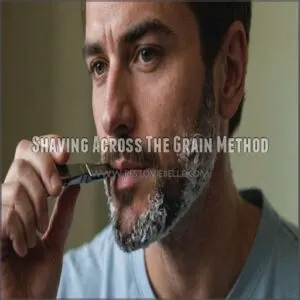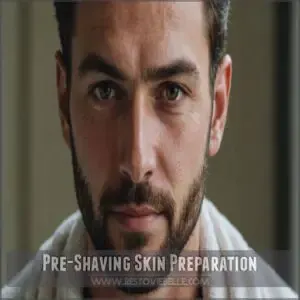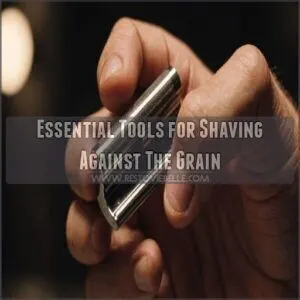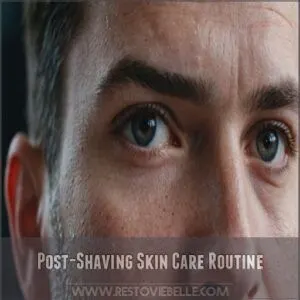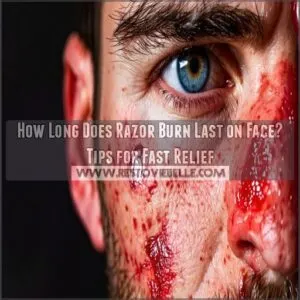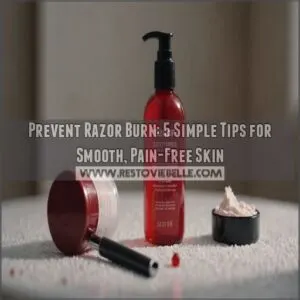This site is supported by our readers. We may earn a commission, at no cost to you, if you purchase through links.

Shaving against the grain can give you a closer shave but also risks irritation and ingrown hairs.
Imagine it like petting a cat backward—not always a good idea!
Shaving with the grain is gentler on your skin and helps prevent razor burn.
To master it, simply determine the hair growth direction by running your hand over the area; the resistance you feel going opposite indicates the grain.
Light strokes and frequent razor rinsing are key here.
Curious about more shaving secrets?
Table Of Contents
- Key Takeaways
- What is Shaving Against The Grain
- Analyzing Your Beard Growth Pattern
- Choosing The Right Shaving Technique
- Pre-Shaving Skin Preparation
- Essential Tools for Shaving Against The Grain
- Steps for Shaving Against The Grain
- Safety Precautions for Sensitive Skin
- Advanced Shaving Techniques for Optimal Results
- Common Mistakes to Avoid When Shaving Against The Grain
- Post-Shaving Skin Care Routine
- Frequently Asked Questions (FAQs)
- Conclusion
Key Takeaways
- To prevent irritation, use a sharp razor to shave in the direction of hair growth, as shaving against the grain can cause razor burn and ingrown hairs. Shave with the grain to minimize irritation and reduce the risk of razor burn, especially if you have sensitive skin.
- Shaving against the grain offers a closer shave but increases the likelihood of ingrown hairs and skin irritation, so use it sparingly and with caution.
- Understand your beard’s growth pattern to tailor your shaving technique effectively—create a beard map to identify the direction of growth.
- Preparation is crucial: clean, exfoliate, and apply pre-shave products to create a smooth canvas, minimizing risks associated with different shaving techniques.
What is Shaving Against The Grain
When you shave against the grain, you’re moving your razor in the opposite direction of your hair growth to achieve the closest possible shave.
You’ll notice this technique cuts the hair beneath the skin’s surface, which can give you incredibly smooth results but may also increase your risk of skin irritation.
Definition and Benefits
Shaving against the grain means running your razor opposite to your hair’s growth direction.
This technique offers the closest shave possible, leaving your skin incredibly smooth.
It’s like mowing your lawn backwards – you catch every blade.
You’ll enjoy longer-lasting results and a sleek, polished look.
However, it’s not for everyone, so understanding your skin and hair type is essential before diving in.
Risks and Suitable Skin Types
While shaving against the grain offers a close shave, it’s not for everyone.
You’re more likely to experience:
- Razor burn and irritation
- Ingrown hairs
- Cuts and nicks
If you have sensitive skin, proceed with caution.
Dry skin types may find it harsh, while oily skin might fare better.
Always test a small area first.
Remember, your skin’s comfort is key – don’t sacrifice it for smoothness.
Analyzing Your Beard Growth Pattern
Understanding your beard’s growth pattern is essential for achieving a close, comfortable shave.
You’ll need to identify the direction of hair growth on different areas of your face.
Create a beard map to guide your shaving technique.
Identifying With-the-Grain Direction
Three key steps help you identify your beard’s with-the-grain direction.
First, let your facial hair grow for a few days.
Then, use these methods to map your growth pattern:
| Method | Technique | Result |
|---|---|---|
| Visual | Examine in bright light | Observe hair lean |
| Touch | Stroke beard gently | Feel smoothest direction |
| Card test | Slide card across face | Note easiest glide path |
Understanding your unique growth pattern is essential for a comfortable, effective shave.
Identifying Against-the-Grain Direction
Now that you’ve identified the with-the-grain direction, let’s flip the script.
Finding the against-the-grain direction is just as important for a smooth shave.
It’s the opposite of your hair’s natural growth pattern.
Here are three ways to pinpoint it:
- Run your fingers across your stubble
- Use a credit card to feel for resistance
- Try the cotton ball test for subtle differences
These techniques help you map out your unique beard terrain, ensuring you’re armed with knowledge for the perfect shave.
Using a Beard Map for Visualization
Creating a beard map helps you visualize your hair growth patterns.
Grab a pen and paper, or use a digital tool, to sketch out your face.
As you run your hand over different areas, note the direction of growth with arrows.
This personalized map becomes your shaving guide, ensuring you always know which way to go for that smooth, irritation-free finish.
Choosing The Right Shaving Technique
You’ll need to decide between shaving with, against, or across the grain for the best results.
Each technique offers different benefits and drawbacks, so understanding them will help you achieve the perfect shave for your skin and preferences.
Shaving With The Grain Method
Shaving with the grain is your go-to technique for a smooth, irritation-free shave.
This method involves gliding your razor in the direction your hair grows, reducing the risk of nicks and razor burn.
For best results, use a high-quality razor blade, such as those found at Razor Blade Store, to minimize tug and pull.
Here’s what you need to know:
- Identify your hair growth pattern before starting
- Use light pressure and short, gentle strokes
- Rinse the blade frequently to prevent clogging
- Follow up with a moisturizing aftershave balm
While not the closest shave, it’s ideal for those with sensitive skin or prone to ingrown hairs.
Shaving Against The Grain Method
After mastering with-the-grain shaving, you might want to try going against the grain for an ultra-close shave.
This technique involves shaving in the opposite direction of hair growth.
While it can give you incredibly smooth results, it also increases the risk of irritation and ingrown hairs.
To minimize these issues, use a sharp razor, proper lubrication, and gentle pressure.
Always test on a small area first.
Shaving Across The Grain Method
The middle ground between with and against the grain, shaving across the grain offers a balanced approach.
You’ll move the razor perpendicular to your hair growth, often as a second pass.
This technique, like the cheek-to-chin method, works well for sides and chin areas, and can be particularly useful for those with sensitive skin, as it reduces the risk of skin irritation and razor burn.
Remember to use light pressure and short strokes.
It’s a smart way for those seeking a closer shave without risking too much irritation.
Pre-Shaving Skin Preparation
Proper skin preparation is very important for a smooth, irritation-free shave.
You’ll need to clean and exfoliate your skin.
Then, apply pre-shave oil and shaving cream to create the best surface for your razor.
Cleaning and Exfoliating The Skin
Before you pick up that razor, let’s talk prep work. Exfoliating with the right sensitive skin blades can make a huge difference in preparing your skin for a smooth shave. Clean skin is your foundation for a smooth shave. Start by washing your face with warm water and a gentle cleanser. This removes dirt and oil, giving you a clean canvas.
Next, grab an exfoliating scrub or brush. Gently buff away dead skin cells in circular motions. This unclogs pores and lifts hair, setting you up for a closer, more comfortable shave.
Applying Pre-Shave Oil and Shaving Cream
You’ve scrubbed away the day’s grime, and now it’s time to soften up.
Using pre-shave oil can make shaving smoother, helping the blade glide effortlessly.
Follow these steps:
- Choose oil types wisely; jojoba or almond work well.
- Spread the oil evenly.
- Apply shaving cream with a creamy consistency.
- Embrace DIY options if preferred.
Essential Tools for Shaving Against The Grain
To achieve the closest shave possible against the grain, you’ll need the right tools.
These include a sharp razor (straight, safety, or cartridge), a quality shaving cream or oil for lubrication, and a soothing aftershave balm to minimize irritation.
Razors and Blade Options
Grabbing your razor marks the next big step.
You’ve got choices: disposable razors, safety razors, or the classic straight razor.
Each offers a unique experience, balancing blade sharpness and lifespan.
If you have sensitive skin, you might want to check out this website for the best razor for sensitive skin: https://zon.everysimply.com/best+razor+for+sensitive+skin/dp/.
Dispose with ease, or nurture a safety razor’s precision.
Ready to master the art?
A straight razor’s audacity might just be your next mastery level.
Remember, control’s yours!
Shaving Brushes and Pre-Shave Oils
While choosing the right razor matters, embracing shaving brushes and pre-shave oils truly elevates your routine.
Brush types range from badger to synthetic, each offering unique exfoliation.
Pre-shave oils soften hair and skin, enhancing glide.
To minimize irritation and ingrown hairs, it’s essential to understand shaving techniques.
DIY oil blends offer a personal touch.
Remember, brush care keeps it pristine.
Oil application primes your skin’s canvas, ensuring a closer, smoother shave.
Aftershave Balms and Moisturizers
Once your shave is complete, it’s time for aftershave balms and moisturizers to shine.
They calm and hydrate:
- Aftershave balm ingredients: Look for soothing, natural options.
- Natural alternatives: Aloe and tea tree oil work wonders.
- Fragrance options: Choose subtle scents for daily wear.
- Applying aftershave: Gently massage on your skin, adding it to your routine for lasting smoothness and comfort.
Steps for Shaving Against The Grain
To shave against the grain effectively, hold the razor at a low angle and use gentle strokes to minimize irritation.
For an even closer shave, consider shaving across the grain after the initial pass.
Holding The Razor and Angle
To ace shaving against the grain, master your razor grip and blade angle.
Position your hand comfortably, and let your wrist guide, not force, the razor.
Maintain light shaving pressure—think of skimming cream off a latte.
Precision is key; small wrist movements guarantee control.
Visualize each stroke as a gentle wave, enhancing both mastery and freedom.
Making The Cut With Gentle Strokes
You’ve got your razor at the right angle, now focus on making the cut with gentle.
Keep skin tension steady and control your shaving speed, remembering to shave with the grain to minimize ingrown hairs and razor burn, as recommended when using single-blade safety razors.
Blade sharpness matters—feel the glide rather than force it.
Pressure control is key; don’t press down hard. Let the razor do the work, and enjoy a smooth, comfortable shave.
Shaving Across The Grain for a Closer Shave
After mastering gentle strokes, try shaving across the grain.
This technique, often used as a second pass, refines your shave.
Think of it as the finishing touch.
To achieve this, you can use a shaving razor from a reputable online store like Shaving Razors Online.
Here’s how:
- Use light pressure.
- Employ the cheek-to-chin method.
- Avoid harsh strokes to prevent skin irritation.
This extra step yields a remarkably close and smooth shave.
Safety Precautions for Sensitive Skin
When shaving with sensitive skin, choosing a gentle shaving cream with soothing ingredients such as aloe vera, glycerin, or oatmeal from the best sensitive skin shave cream can help minimize irritation and avoid ingrown hairs by using gentle techniques and suitable products.
Regular exfoliation can help maintain healthy skin, ensuring a smooth shave whether you choose to go with or against the grain. Understanding your hair growth direction is crucial when deciding to shave against the grain, as it involves feeling for resistance. Regular exfoliation can help maintain healthy skin, ensuring a smooth shave whether you choose to go with or against the grain.
Avoiding Irritation and Ingrown Hairs
Avoid razor burn and ingrown hairs by mastering your skin care routine and understanding the key differences between conditions like razor burn vs razor bumps. Avoid razor burn and ingrown hairs by mastering your skin care routine.
Use a sharp razor and proper shaving technique.
Those with sensitive skin should exfoliate regularly and apply light pressure when shaving.
Always shave with confidence, knowing your skin needs some TLC to stay irritation-free.
Let your face enjoy the freedom of smooth, comfortable shaving.
Exfoliating for Healthy Skin
Think of exfoliating as giving your skin a fresh start.
It sheds dead layers, revealing smoother skin beneath.
Exfoliating before shaving can also help create a smooth surface for the razor to glide over, reducing friction and the risk of razor burn and irritation.
Use gentle exfoliating tools suited to your skin type.
Scrub frequency matters; aim for once or twice a week to avoid irritation.
DIY scrubs with natural ingredients add a personal touch, enhancing the benefits of exfoliation without breaking the bank.
Advanced Shaving Techniques for Optimal Results
Incorporating advanced shaving techniques can greatly enhance your grooming routine, providing a closer and smoother shave.
By mastering methods like the sideways shaving approach and using a sharp razor, you can combine different techniques to achieve excellent results.
Mastering The Sideways Shaving Method
To tackle the sideways shaving technique, focus on your razor angle and maintaining skin tension.
Imagine your face as a map—you’ll maneuver the blade across your skin’s "latitude."
Keep a keen eye on pressure control; it should be as gentle as petting a cat.
This method’s your ticket to precision, ensuring a smoother journey without irritating sensitive skin.
Using a Sharp Razor for a Closer Shave
A sharp blade is your secret weapon for a smooth shave.
Dull blades tug and pull, causing irritation.
Keep your razor sharp for a superior shave.
Here’s how:
- Regular blade changes are key.
- Proper shave prep softens your beard.
- Store your razor properly to prevent rust and damage.
Combining Shaving Techniques
While combining shaving techniques, imagine orchestrating a perfect symphony.
By mixing shaving with, across, and against the grain, you’ll achieve your closest shave.
Each pass manages grain variations, reducing skin irritation.
Choose your razor wisely to make sure each stroke is smooth.
This multi-pass shaving mastery grants you control, precision, and freedom from pesky nicks, making shaving an art.
Common Mistakes to Avoid When Shaving Against The Grain
When shaving against the grain, it’s easy to apply too much pressure or shave over the same spot, leading to irritation and razor burn.
To achieve a smooth shave, make sure to prepare your skin properly with the right products and techniques.
Applying Too Much Pressure and Shaving Over The Same Spot
Every shaver’s nightmare is when too much pressure transforms a routine shave into a horror show.
Skin irritation, razor burn, redness—it all starts there.
Applying light, consistent pressure is essential to avoid blade dulling and ingrown hairs.
Avoid dragging your blade over the same spot multiple times, as this can amplify irritation and leave your skin longing for relief.
Not Preparing The Skin Properly
Just like applying too much pressure, not prepping your skin can lead to razor burn and ingrown hairs.
Picture dry skin as a stubborn canvas resisting every swipe of the brush.
Wash your face with warm water to open pores, exfoliate gently, and apply pre-shave oil.
This sets the stage, minimizing shaving bumps and skin irritation.
Post-Shaving Skin Care Routine
After finishing your shave, taking care of your skin is very important to prevent irritation and keep it healthy.
Start by applying an aftershave balm and moisturizer.
Then, exfoliate gently.
Applying Aftershave Balm and Moisturizer
Using an aftershave balm and moisturizer in your post-shave routine is like giving your skin a comforting hug.
When choosing an aftershave balm, opt for one with natural ingredients like aloe vera, as it can help soothe and reduce irritation.
Balms soothe and reduce irritation, while moisturizers lock in hydration.
Don’t just splatter it on—dab gently using your fingertips, focusing on areas prone to dryness.
This quick step will help keep your skin smooth and refreshed like an expert.
Exfoliating and Protecting The Skin From The Sun
After shaving, gently exfoliate to remove dead skin cells and prevent ingrown hairs. This simple step boosts your skin’s health.
Don’t forget sun protection! Your newly shaved skin is extra sensitive.
- Sun protection products are your new best friend.
- Exfoliation benefits go beyond just a smooth face.
- A consistent skin care routine is key.
- Post-shave sun protection is essential, especially for sun-sensitive skin.
- Mastering this routine gives you the freedom to enjoy a perfect shave every time.
Frequently Asked Questions (FAQs)
How often should I shave against the grain?
Shave against the grain sparingly, ideally once or twice a week, to minimize irritation and ingrown hairs.
Make sure your skin is well-prepared with pre-shave oil and proper technique to reduce the risk of discomfort.
Can shaving against the grain prevent razor bumps?
Think of razor bumps as pesky party crashers.
Shaving against the grain might seem like a solution, but it often leads to more bumps.
Instead, shave with the grain or use proper skin prep to reduce irritation.
Is using cold water better after shaving?
Applying gentle shaving techniques and using the right razor type, such as those that help prevent razor burn causes, can also reduce skin irritation. Splashing cold water on your face after shaving can soothe the skin and reduce razor burn.
It tightens pores, reducing the risk of bacteria entering.
This practice leaves the skin refreshed and helps prevent irritation.
What types of razors work best for beginners?
For beginners, cartridge razors are the easiest to use.
They’ve multiple blades and a pivoting head, reducing the chance of nicks and cuts.
They’re widely available, affordable, and perfect for a straightforward shaving experience.
How does skin type affect shaving method?
Sensitive skin? Shave with the grain for a gentler experience. Tougher skin? Experiment! Against the grain offers a closer, longer-lasting shave, but might cause irritation. Listen to your skin.
Conclusion
Deciding whether to shave with or against the grain is like picking the right path on a tricky road.
With careful consideration of your skin type and desired results, you can find the best technique.
Shaving with the grain offers a gentle approach, reducing irritation, while going against the grain provides a closer shave.
Ultimately, understanding your beard growth, prepping your skin, and using the right tools will lead to smoother shaving experiences and healthier skin.







